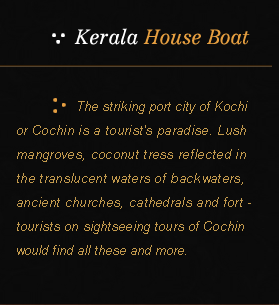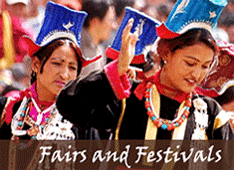
Location : Chennai - Kanchipuram - Mahabalipuram - Pondicherry - Chettinad - Madurai - Kanya Kumari - Kovalam - Alleppey - Kumarakom - Thekkady - Cochin - Ooty - Coonoor - Mysore - Bangalore.
Chennai Arrival:
COMPANY REPRESENTATIVE will receive you on arrival at the airport and transfer to the hotel.
Chennai was established only in the 17th century by the British, some parts of the city like Triplicane and its outskirts are almost 2000 years old. The British on settling developed it into a major urban centre and naval base. By the 20th century, it had become an important administrative centre, as the capital of the Madras Presidency.
The city's former name, Madras, is derived from Madraspatinam, a fishing village north of Fort St. George. There is little agreement among researchers about the exact origin of the name Madraspatinam. Some believe that the Portuguese, who arrived in the area in the 16th century, may have named the village Madre de Deus. Others believe that the village's name came from the once prominent Medeiros family (variously known as Madera or Madra in succeeding years) of Portuguese origin, which had consecrated the Madre de Deus Church in the Chennai locality, Santhome, in 1575. It is uncertain whether the name 'Madraspatinam' was in use before European influence.
Sometime after the British gained possession of the area in the 17th century, the two towns, Madraspatinam and Chennapattinam, were merged. The British referred to the united town as Madraspatinam. The state government officially changed it to Chennai in 1996, at a time when many Indian cities were being renamed.
Chennai is an important center for Carnatic Music and hosts a large cultural event, the annual Madras Music Season, which includes performances by hundreds of artists. The city has a vibrant theatre scene and is an important centre for the Bharatnatayam, a classical dance form. The Tamil film industry, one of the largest film industries in India, is based in the city; the soundtracks of the films dominate its music scene.
Overnight will be at Chennai.
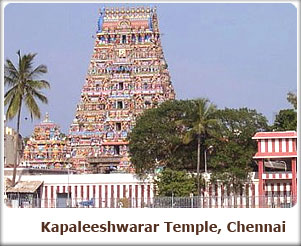 Day 02
Day 02
Chennai:
Breakfast will be at the hotel.
Fort ST. George: was built in 1640 AD, by the British East India Company under the direct supervision of Francis Day and Andrew Cogon. This place achieved its name from Saint George, the patron saint of England. The fort houses Saint Mary's Church and fort museum. Saint Mary's Church the oldest Anglican Church built in 1680 and the tombstones in its courtyard are the oldest British tombstones in India.
San Thome Basilica: at the south end of Marina Beach was named after Saint Thomas "doubting apostle of Jesus Christ". It is believed he has come to Madras in 52 AD and kill at St. Thomas Mount just outside the city in 78 AD. Built in 16th Century by the Portuguese, in 1896 it was made a basilica. The beautiful stained glass window at the basilica portrays the story of St Thomas and the central hall has 14 wooden plaques depicting scenes from the last days of Christ.. In the cathedral is a 3ft. high statue of Virgin Mary which is believed to have been brought from Portugal in 1543
Theosophical Society: formed to facilitate and encourage the study of comparative religion, philosophy and science is situated in beautiful sylvan settings in Adyar. The society was founded by Madame Blavatsky and Col. Olott in USA, and later moved to Adyar in 1882. Apart from shrines of all faiths and the peaceful Garden of Remembrance, there is a 95-year old library which has a very good collection of rare Oriental manuscripts written on palm leaves and parchment
Rippon Building: Another pride of Chennai city, this 100 year old building was named after Governor Lord Rippon, the father of self-government in India. The Chennai Corporation and its council are functioning in this building. (Entry time – 10 am to 03 pm)
Kapaleeswarar Temple: Dedicated to Lord Shiva, Kapaleeswarar temple has inscriptions from the 13th century A.D. The temple 'Gopuram' (tower) is in the characteristic Dravidian style of architecture. The walls and pillars of temple have very delicate and intricate carvings which depict the scenes from Hindu mythology.
Government Museum: previously known as Pantheon Complex in British period, today houses the Government Museum, Connemara Public Library and the National Art Gallery. The museum contains exhibits ranging from contemporary artifacts to pre historical findings. Sculptures and bronzes of various periods, sections for zoology, anthropology and geology impress every visitor. Buddhist sculptures found in the Amaravathi section depict the events recorded in the life of the Buddha
Marina Beach: It is the second longest beach in the world with a stretch of 4.5 Kms (2.5 miles). This strech is filled with statues of remembrance from our Tamil culture to our great leaders. A walk along the Marina in the evening creates elated feelings. The old buildings on side of Kamarajar Salai, a main road along the Marina, would remind you of the good old British days. People from all over the city gather here in the evenings to cool off and eat crispy "sundal and murukku"!
Enjoy Bharatnatayam Dance Presentation in evening.
Overnight will be at Chennai.
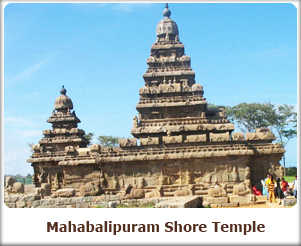 Day 03
Day 03
Chennai – Kanchipuram - Mahabalipuram:
By Road 75Kms/02 hrs
After breakfast drive to Mahabalipuram visiting Kanchipuram enroute.
Kanchipuram: Kanchipuram is a small rural town about 75 km from Chennai (Madras) in the state of Tamilnadu. It also serves as the district head quarters for the Chengalpattu district. Its economy is entirely dependent on tourism and the well established handloom industry. Silk sarees manufactured here are one of the best in the entire world. Is one of the India’s seven sacred cities it was the historical Capital of the Pal lavas. This city is also a world renowned for the gorgeous hand woven silk. Saris of myriad rich colors, noted for their shine, finish and matchless beauty. The Exquisite silk saris are woven from the pure mulberry silk in contrasting colors and have an enviable reputation for luster, durability and finish.
Continue drive to Mahabalipuram. Reach Mahabalipuram and check into the hotel.
Mahabalipuram or Mamallapuram was an ancient port city on the Coromandel Coast faces the Bay of Bengal, built by the Pallava Dynasty in the 7th century. It was named after the cruel demon king Mahabali, who was slayed by Goddess Durga, and is an important World Heritage Site today. It is 60kms from Chennai, and can be reached by the scenic East Coast Road.
It was during the reign of King Narasimha Varman I, the name Mahabalipuram was changed. It was renamed Mahabalipuram which is called till now. There is a story behind. The name Mamallapuram king Narasimha Varman I was a great and valiant warrior. He was given the title Mamalla which means ‘the great wrestler’ so the name was converted from Mahabalipuram to Mahabalipuram considering the great king and his achievements.
The richness in Mahabalipuram was not known to many, as these Pallavas did not outlet and expose their quality and innovative creations to the outer world for obvious reasons. The aestheticism in Mahabalipuram was hidden until the late 185h century. What is special about Mahabalipuram? Of course every one can point out the rock - cut caves, temples made from a single rock, temples and strives of different structures, and bas-reliefs which are so artistic and sheer creativity. Mamallapuram is referred as an ‘open-air museum’. The great Pallava kings Narasimha I and Rajasimha have well preserved these stylistic qualities that one enjoys in Mahabalipuram even in the present day.
The beauty of the place is not only due to these architecture but the vast casuarinas trees, the silvery sandy beach the classical hand male crafts around have made them all to form what is a collective splendor. Any visitor who visits Mahabalipuram will remain startled and intoxicated with the grandeur. They feel hand hearted and more out from this historical and fascinating tourist spot.
Mahabalipuram is known for the beautiful historical monuments that were built mostly during the Pallava Dynasty in the form of rock cut caves and temples. It’s beautiful and unspoilt beaches stretching for miles, and lined by groves of casuarinas is another great attraction.
Buy stone carvings made by the local artists; chill on the sandy beaches; drink beer and try the local cuisines.
Overnight will be at Mahabalipuram.
Day 04
Mahabalipuram:
Breakfast will be at the hotel.
Enjoy visit to the following places:
Caves: The Varaha Cave shows two incarnations of Vishnu-Varaha (boar) and Vamana (dwarf) along with four panels of the famous Pallava doorkeepers in contemplative reverie. It is the lyrical softness and grace of these supposed to be macho-guards that make them attract the attention of the tourists. The 7th century Mahisasurmardini Cave has fine bas-reliefs on its panels while the Dharmaraja Cave sports three empty shrines. The other highlights of these caves are the Somaskanda, masterpiece of 'dhwani' (the art of suggestion) depicting Lord Vishnu and a huge theatrical panel showing Goddess Durga's fight with the demon Mahishasura. Just 5 km from the city is another 7th century cave called Tiger Cave, a rock-cut shrine.
Arjuna's Penance: Arjuna's Penance is 27 metres long and 9 metres high bas-relief believed to be the world's largest bas-relief. It consists of two huge boulders with a cleft in the rock that depicts the descent of the Ganga on Earth to fulfill the wish of King Bhagiratha to redeem the cursed souls of his ancestors. The carvings depict two large elephants, scenes from the tales of Panchatantra, a forest with tribal people, all forms of animal life and graceful women beaming with inner beauty. The whole scene seems to have a subtle touch edge of humor that is evident in the cat doing rigorous penance against an ascetic.
Rathas: The famous Rathas or Chariots are situated at the southern extreme of Mahabalipuram. Known as the Paanch Pandava Rathas, after the five characters of Mahabharata, four of them are carved out of a single rock. The Draupadi and Arjuna Rathas are square in shape while the Bhima Ratha is linear in shape. Dharamraja Ratha is tallest of all and Nakula-Sahadeva Ratha is apsidal.
Krishna Mandapam: One of the earliest rock-cut temples of Mahabalipuram, its walls depict scenes of Krishna's pastoral life. One of them depicts Krishna lifting the Govardhan Parvat on his little finger to protect his people from wrath of the Rain God, Indra.
Shore Temple: The best of all at Mahabalipuram is its Shore Temple. It houses one Vishnu temple and two Shiva temples that are all architectural masterpieces in themselves. The sea waves lashing all around make for pretty scenery for the temples.
You could also visit the Sculpture Museum, home to many beautiful sculptures, and the old and new lighthouses which give you a panoramic view of sea.
Overnight will be at Mahabalipuram.Day 05
Mahabalipuram – Tiruvannamalai – Pondicherry:
By Road 112Kms/03hrs
After breakfast drive to Tiruvannamalai a pilgrim centre with an ancient temple of Lord Shiva.
After lunch at local restaurant, proceed to Pondicherry. Reach and check into the hotel.
Pondicherry is a Union Territory of India. It is a former French colony, consisting of four non-contiguous enclaves, or regions, and named after the largest region, Puducherry. The territory was known as Pondicherry until 2006 when it was given the name for which the region was known prior to foreign rule. There are four districts which comprise this territory namely Pondicherry, Karaikal, Yanam and Mahe. Pondicherry is referred by names such as ‘Quintessence of French Culture’, ‘India’s Little France’ and ‘The French Riviera of the East’. This territory was under the French rule for nearly 281 years. Still it has the French flavor in it as one can see by the grand colonial mansions, beautiful boulevards, and placid promenades, spellings on sign boards and buildings, names of roads and public places.
The Union Territory of Pudhucherry (earlier Pondicherry) comprises of the four unconnected, erstwhile French settlements of Pudhucherry, Karaikal, Mahe and Yanam. While Karaikal lies 150 km south of Pudhucherry on the east coast, Mahe is on the Malabar Coast and Yanam in the East Godavari district of Andhra Pradesh.
Tourist attractions in Pondicherry lie in its ambience. Old French style buildings, churches and museums, tree-lined boulevards along the seashore would remind you of a bygone era. The Laidback Township, pristine beach and the palm trees swaying in breeze bring a slice of serenity. The only sound you can hear is the waves crashing against the rocks and the chirping of the birds.
But to cap it all, the Auroville Ashram is the biggest of all tourist attractions in Pondicherry. Just because of it, the destination of Pondicherry exudes a spiritual aura. For the weary soul, this is an ideal retreat. Any evening head for the Ashram meditate, soothe the battered psyche.
Drive to visit Aurobindo’s Ashram which is also known as “the city of dawn”. The place is 10 km north of Pondicherry. This ashram promotes Shri Aurobindo’s ideas in bringing about a synthesis of Yoga and modern science, so as to unite the spirit and matter.
Enjoy heritage walks, cover French and Tamil sectors.
Overnight will be at Pondicherry.Day 06
Pondicherry – Kumbakonam - Chettinad:
By Road 286Kms/05hrs
Breakfast will be at the hotel.
You can also choose to visit a few other monuments that are located in the city. The French War Memorial, the Aayi Mandapam, a 19th Century Lighthouse, Romain Rolland Library, the Museum are other tourist attractions in Pondicherry. The old Parisian churches would draw you attention due to their architectural beauty.
Later drive to Chettinad enroute visiting the Brass factory at Kumbakonam.
Reach Chettinad and check into the hotel.
The traditional CHETTINAD houses are made on an area of 2500 sq ft having around 60 to 70 rooms. They were built almost 100 years back. They were made of lime, sand and egg yolk especially imported from Rangoon. The construction material, decor items and furnishings were mostly imported from East Asia Europe. The chandeliers and teak came from Burma, crockery from Indonesia, marble from Italy, wall-to-wall mirrors from Belgium and crystals from Europe. French and other European destinations inspired the woodwork and stonework.
The city of Chettinad located along the coast of Tamil Nadu is also renowned for its rich Cultural Heritage and is one of the major Tourist Destinations in South India. The architectural grandeur of the place is worth mention and one cannot deny the exquisite array of cultural extravaganza that lures the tourist to this destination. The splendid mansions, ancient houses stand boldly exhibiting the magnificent architectural skill of the people of Chettinad.
The houses in Chettinad has been erected on a rectangular plot, across two streets, they have superb interior planning. If you come to see one of these buildings you would wonder at the architectural skill of the ancient artists who had the talent to erect such magnificent structures without the aid of the Interior Decorators! The 100 years old Chettinad Palace is a special Tourist Attraction at this place and one can hardly deny the splendor of the artifact. It has been constructed with materials brought from Italy and Burma, Indonesia and Belgium.
Overnight will be at Chettinad.
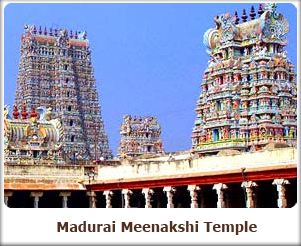 Day 07
Day 07
Chettinad – Madurai:
By Road 120Kms/03hrs
Breakfast will be at the hotel.
Drive to Madurai. Reach Madurai and check into the hotel.
Traveling to Madurai is always a humbling experience for a discerning tourist as the holy city has some of the grandest temples in its womb that make your visit more of a pilgrimage. The city is among the oldest in India, a flourishing seat of art and culture since the Sangam period.
One of the oldest cities of India, with a cultural heritage dating back to 2,500 years, Madurai is situated on the banks of the River Vaigai and is the second largest city of Tamil Nadu.
The city was the capital of the Pandyas and later the Nayakas and is famous for its Meenakshi temple dedicated to Sundareshvara (Shiva) and his consort Meenakshi (Parvati).
Madurai is derived from the name Madhurapuri, standing for the nectar that was showered upon the city as blessings from Lord Shiva's locks.
Overnight will be at Madurai.
Day 08
Madurai:
After breakfast proceed for city tour of Madurai.
Meenakshi Amman Temple: The city of Madurai is originally built around the Meenakshi temple. Though there are many temples in the city, Meenakshi temple outdoes all with its sheer magnificence and splendor of architecture. You can marvel the temple's flawless Dravidian Architecture and be a part of devotees who throng the temple from all over India. If you wished to have a bird's eye view of the city, you could also climb the southern Gopuram of the temple see to get a great view of the city.
Koodal Azhaar Temple: Among the most ancient temples in Madurai Koodal Azhagar temple stands high. It is dedicated to Lord Vishnu. You could see him in various postures sitting, standing, reclining one over the other. Apart from that there are intricate woodcarvings, one of them depicting Lord Rama's coronation.
Thirumalai Nayak Mahal: Built in 1523 AD by the Nayak ruler Thirumalai Nayak, the palace is an excellent example of Indo-Saracenic architecture. Once four times larger than what is left of it today, the palace is only left with the main entrance gate, the dancing hall and the main hall. You can enjoy the main attraction of the palace which is light and sound show based on the life of "Tirumalai Nayak" and "Silapathikaram".
Vanditur Mariamman Teppakulam: Built by Thirumalai Nayak in 1646, this huge tank covers an area equal to the six of Meenakshi temple. Some sources say that this tank was once connected to Vaigai River, however today it lies empty except during the Teppam Festival.
The Gandhi Museum: All those with interest in Gandhi's philosophy may well plan a visit to this museum, which has some of the little known facts about Mahatma Gandhi. The museum has a real Gandhi Memorabilia in the form of a blood stained dhoti, which he was wearing at the time of his assassination. The museum is the repository of various testimonies relating to the freedom movement of India.
Thirupparankundram: As one of the abodes of Lord Sundareshvara, it is a rock cut temple carved out of a mountain, just 8-km from the city.
Azhagar Koil: Dedicated to Lord Vishnu, the temple is located 18-km northeast of Madurai on a picturesque hilltop. You can attend Chithirai festival when the gold image of Azhagar travels for the Celestial marriage.
Pazhamudhirsolai: It is one of the six abodes of Lord Subramanya on the same hills of Azhagar Koilths.
Overnight will be at Madurai.
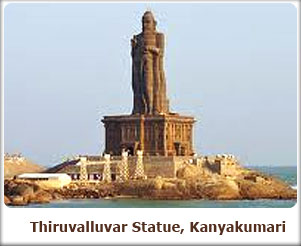 Day 09
Day 09
Madurai – Kanyakumari:
By Road 290Kms/06hrs
Breakfast will be at the hotel
Drive to Kanyakumari. Reach and check into the hotel.
Kanyakumari was once referred to as the "ALEXANDRIA OF THE EAST”. This place has been a great centre for art, culture, civilization and pilgrimage for years. It was also a famous centre for commerce and trade. During the early part of the 8th century A.D, Islam entered the southern part of India through the sea route with traders and Missionaries. Through Saint Thomas, one of the twelve Apostles of Christ, Christianity arrived in this area in 52 A.D. Islam. Christianity and Jainism religions have greatly contributed to the Architectural wealth and literal heritage of this place. Kanyakumari was also under the control of the Cholas, the Cheras, the Pandyas and the Nayakas who were the great rulers of South India. The architectural beauties of the temples are the beautiful work of these rulers.
The shore temple in this famous Pilgrim centre is dedicated to the virgin goddess Devi Kanyakumari, who eternally protects the country. The temple is a symbol of unity and sanctity.
Relax and enjoy the sightseeing.
Overnight will be at Kanyakumari.
Day 10
Kanyakumari – Kovalam:
By Road 120Kms/02hrs
Breakfast will be at the hotel.
Drive to Kovalam. Reach Kovalam and check into the hotel.
Kovalam went through a gradual metamorphosis from an obscure fishing village to a contemporary holiday destination. A natural bay created by a breathtaking rock cluster and three crescent shaped beaches make up the stunning and very beautiful Kovalam beach in Kerala, South India. Though frequented often, the very beautiful Kovalam beach glows in its un-spoilt beauty and offers a relaxing holiday to a tired and wandering soul. Life at the tiny fishing village located on the Kovalam coast goes on as it did for ages. Take walk near the fishing village in Kovalam and be enthralled at the simplicity, happiness and contentment that greet you.
Kovalam is an internationally renowned beach of Kerala, with three adjacent crescent beaches. Kovalam has been a favorite haunt of tourists, especially Europeans, since the 1930s. A massive rocky promontory on the beach has created a beautiful bay of calm waters ideal for sea bathing. The leisure options at this beach are plenty and diverse - sunbathing, swimming, herbal body toning massages, special cultural program, Catamaran cruising etc. The tropical sun acts so fast that one can see the faint blush of coppery tan on the skin in a matter of minutes. Life on the beach begins late in the day and carries on well into the night.
Kovalam has three crescent shaped beaches - Lighthouse beach, Hawah Beach and Samudra Beach. Rocky outcroppings separate the three.
Lighthouse beach is the most popular of the three. Vizhinjam lighthouse stands proudly on Kurumkal hillock near the beach and hence the name. Further south on the beach one can have a spectacular view of the Vizhinzam mosque.
Hawah beach, also called as Eve’s beach is clean and in the morning acts as base for the local fishermen. During the heydays of hippies, it was popular as a topless beach.
Samudra beach is on the extreme north and most of the expensive resorts are located at Samudra beach. Samudra beach is often referred to as Ashoka beach or Leela beach (owing to the resorts located on the beach). At Samudra beach, you can go on a catamaran with local fishermen.
Overnight will be at Kovalam.
Day 11
Kovalam:
Breakfast will be at Hotel.
Relax at the beach and spend the day in leisure.
Overnight will be at Kovalam.
Day 12
Kovalam – Alleppey:
By Road 165Kms/04hrs
Breakfast will be at the hotel.
Proceed to Alleppey. Alappuzha or Alleppey is a place where beauty abounds and nature’s surprises await you at every turn. This land of timeless beauty will hold spectators captivated with its lush greenery, emerald backwaters and sparkling white-sand beaches. Situated in the southwestern part of Kerala, the place is famous for its stunning natural splendors. Alleppey, popularly known as the “Venice of the East”, is famous for its labyrinthine network of backwaters and canals and its extensive sea shore stretching over 82 km.
Check into a traditional houseboat of Kerala Style and go on a leisurely backwater cruise along the lake on a thatched houseboat. The houseboat with all modern comforts lets you discover the countryside at your own pace. You will have lunch, dinner and breakfast in the Houseboat. A ride on the houseboat is a fabulous way to explore the fascinating beauty of the backwaters.
Cruise through the backwaters towards Kumarakom. Lunch will be served on the boat. The menu is simple and traditional. The cook (chef) of the boat prepares the lunch from fresh materials and even you can have a peek at the recipe.
Tea and snacks would be served in the evening. The boat will be anchored in the backwaters along a paddy field and you can go for a stroll into the village or relax at the deck of the boat.
Dinner will be on the boat. Overnight will be at Houseboat.
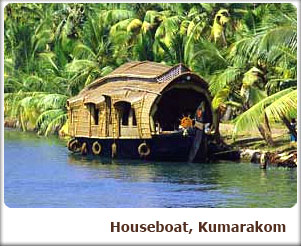 Day 13
Day 13
Kumarakom – Thekkady:
By Road 120Kms/04hrs
Breakfast will be on board.
Cruise through the backwaters watching the children going to school and the village markets opening.
Disembark the boat at the finishing point where your driver will be waiting for you to drive to Periyar.
Proceed to Thekkady. Reach and check into the hotel.
Discover the veritable essence of Kerala’s well kept wilderness secrets at Thekkady. This green oasis is one of the last safe havens for the elusive Indian tiger- an endangered species now on the verge of extinction. This exotic land reminds of a colorful impressionistic painting stirred to life as if by a miracle. Thekkady fantabulous landscape is diffused with exotic spice plantations, green carpets of endless tea gardens and lush tropical forests. Garbed in vibrant hues and bountiful gifts of nature, Thekkady offers a perfect romantic escapade into the soothing laps of Mother Nature.
Thekkady is home to the Periyar Tiger Reserve, one of the best among the 27 tiger reserves in India. The very name of this romantic land conjures up exotic visions of wildlife, plantations, spice scented air, crystal clear lakes and mist covered endless rolling hills. Thekkady epitomizes Kerala’s sublime beauty in all its pristine glory. Come and be overwhelmed with a vacation of your lifetime in this dazzling land of impeccable beauty. Each day in this exotic land is a celebration of life and nature; epitomizing “La Dolce Vita”.
Relax and then enjoy the sightseeing.
Kumily: The quaint town of Kumily lies at a distance of about 4 km from Thekkady nestled in the realms of the majestic Cardamom Hills. The plantation town is surrounded by tea and spice plantations making it an ideal place to study how Indian spices are grown and how they are used in local cuisines. The scenic beauty of the area is further accentuated by its crisp blue skies, lush greenery and mist drenched mountains. This hub of spice trade is located at the vicinity of the Periyar wildlife sanctuary and makes a perfect base to explore the region.
Plantation tours: Do make it a point to visit some of the numerous tea and spice plantations in the area. This is the best way to understand how these exotic spices are grown and to learn how they are used in the local cuisines. Tea factories could also be visited to see how the tea leaves are processed and to meet some of the workers involved in it. There are vanilla, cardamom and spice plantations in the region which could be visited with permission.
Enjoy elephant ride.
Overnight will be at Thekkady.
Day 14
Thekkady:
Breakfast will be at the hotel.
Today you will visit the rare species of plants and animals by taking a short walk and enjoying the safari.
Periyar Tiger trail: A trekking expedition could be organized inside the Periyar Wildlife Sanctuary with the permission of the authorities. There is a set limit to the maximum number of people per expedition and it’s also subjected to meeting certain medical standards. This is because of the strenuous nature of this expedition through the dense remote jungles. The guides for this trail were poachers earlier and are now actively involved in protecting the unique ecosystem and the wildlife of the region.
Trekking and Mountaineering: Trekking is the best way to explore the scenic beauty of the mountainous terrain. Trekking expeditions could be undertaken at the Periyar Wildlife Sanctuary provided you take prior permission from the authorities. You have to take a guide approved by the authorities before you can go trekking inside the jungles.
Bamboo Rafting: This exciting adventure sport is available at the Periyar Wildlife Sanctuary. You can get in touch with the forest authorities for permission to do bamboo rafting in the Periyar Lake. This is one of the best ways to experience the area and to catch glimpses of wildlife at close quarters.
Overnight will be at Thekkady
Day 15
Thekkady – Cochin:
By Road 190Kms/05hrs
Breakfast will be at the hotel.
Proceed to Cochin. Reach and check into the hotel.
The striking port city of Kochi or Cochin is a tourist's paradise. Lush mangroves, coconut tress reflected in the translucent waters of backwaters, ancient churches, cathedrals and fort - tourists on sightseeing tours of Cochin would find all these and more. Flanked by the Western Ghats on the east and the majestic looking Arabian Sea in the west, Kochi occupies a very strategic location and has been a significant trading zone and attractive tourist destination since time immemorial. The tradition and reputation of this enchantingly quaint port city has maintained till date. Here's a list of popular sightseeing places to be seen on a tour of India.
In the early evening proceed for a private harbor cruise. Enjoy watching the dolphins, the fishing island and the Bolghatty Palace. Cruise till the mouth of the sea and enjoy the sunset.
Overnight will be at Cochin.
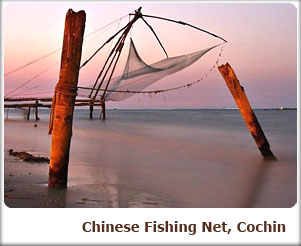 Day 16
Day 16
Cochin:
Breakfast will be at the hotel.
Proceed for a sightseeing tour of the city.
Fort Kochi: Even a casual stroll through Fort Kochi located in the port city of Kochi in Kerala is enough to make you feel transported to another world and time. The architectural style of the buildings and the town layout easily make Fort Cochin distinct from other cities and towns of Kerala. Since Fort Cochin was under the possession of the Portuguese, the Dutch and the British at different points of time, the region still bear the influence of European architecture.
Bolghatty Palace: The splendid Bolghatty Palace is located on the Bolghatty Islands, in the Cochin city of Kerala. The appeal of the palace lies in the fact that it is among the oldest existing palaces built by the Dutch in India, during the pre-British times.
Chinese Fishing Nets: The Chinese fishing nets at Fort Kochi, located in the Kochi city of Kerala, make up a very popular tourist attraction. They are fixed land installations, which are used for a very unique and unusual method of fishing.
Mattancherry Palace: Even though it is austere in its appearance, the Mattancherry Palace of Cochin has a quaint charm of its own. The credit for building this landmark monument partly goes to the Dutch, who captured Cochin city of Kerala during the pre-British period.
Marine Drive: Marine Drive is a beautiful promenade in Kochi (Cochin), Kerala state of India. The Marine Drive is built facing the backwaters of Kochi. It is a popular hangout for the local populace as well as the tourists.
Jewish Synagogue: The Jewish Synagogue in the port city of Kochi is the oldest synagogue in all the Commonwealth of Nations. Thus, it comprises the topmost slot in the itinerary of the tourists visiting the city.
Pareekshith Thampuran Museum: Pareekshith Thampuran Museum is a very good archeological museum located near the Shiva temple, on the Durbar Hall Road at Ernakulam. This museum boasts of an impressive collection of 19th century paintings, ancient monuments and coins, scriptures made in stone and Plaster of Paris, murals as well as memorabilia belonging to the Cochin royal family.
St Francis Church: St Francis Xavier's Church at Fort Kochi was built in the year 1503, by the Portuguese traders. They came here with Admiral Pedro Alvarez de Cabral, via the same route taken by the legendary Portuguese explorer Vasco da Gama, who landed at Calicut in 1498.
Willingdon Island: The Willington Island contains the modern port serving Cochin city of Kerala. The island is an artificial man-made island created from the sand dug out while deepening Kochi port.
Museum of Kerala History: Do not take the Museum of Kerala History in the Cochin city of Kerala as any ordinary museum. The significance of this 'live' museum lies in the fact that it recounts the history of the land through magnificent and informative light and sound shows.
Enjoy Kathakali dance presentation in Cochin.
Overnight will be at Cochin.
Day 17
Cochin – Ooty:
By Road 280Kms/06hrs
Drive to Ooty after breakfast.
Ooty, short for Ootacamund (an anglicized name for Udhagamandalam), is a popular hill resort in the state of Tamil Nadu in Southern India.
The name Udhagamandalam is derived from the TODA word "othakal-mund" which means "house in mountains". Ooty stands at 7,347 feet above sea level in the Nilgiri mountain range. It was founded in the 19th century by the British, and served as the summer headquarters of the Madras Presidency.
Located in the mountainous range called the Nilgiris ("Blue Mountains"), it draws swarms of tourists every year. The weather is quite pleasant at a mean of 15-20°C around the year, dropping to lows of 0°C during winter. The landscape is marked by rolling hills covered with dense vegetation, smaller hills and plateaus covered with tea gardens, and eucalyptus trees. Many portions of the hills are preserved as natural reserve forests, and special permits will be needed to camp in noncamp sites. Ooty is not the destination in itself, as much as it is the focal point of attraction. Auto touring the surrounding country side is certainly a must do. Unfortunately, the hill town suffers from overcrowding and erosion of natural resources. Tourism has placed an enormous strain on the natural resources resulting in pollution, water shortage and roads.
Overnight will be at Ooty.
 Day 18
Day 18
Ooty – Excursion to Coonoor:
Breakfast will be at the hotel.
Enjoy the sightseeing of Ooty and then proceed for an excursion to Coonoor.
Botanical Gardens: This is one of Ooty's most-visited places and is 2kms from town. It dates back to the mid-18th century. Covering an area of 22 acres, it was originally meant as a ground to study the vegetation in and around the hills of Nilgiri. Today it functions as a park open to all. It is home to as many as 650 species of plants and trees, and also happens to be a bird watcher's delight. It also has a fossil of a 200 million year old tree.
Rose Garden: Another popular tourist spot of Ooty, Rose Garden or Mini garden is around 3-4 Kms from the Charring Cross and has a variety of exquisite blooms to see.
Thread Garden: This is home to a variety of flowers and what is unique is that these are not natural flowers but made out of threads. It is believed that it took 12 years to create this garden.
Stone House: This was the first British house built by John Sullivan, which also paved the way for further settlements in Ooty. It is located inside the Government Arts College.
Take the TOY TRAIN (blue train) to Coonoor. This is one of the best highlights of the BLUE MOUNTAINS and enjoys the train ride with plantations on both sides and pretty villages.
Coonoor is a fabulous hill station in the Nilgiri hills about 19 km from Ooty. Coonoor, located at an altitude of 1,856 meters, is the second largest hill station in the Nilgiri hills.
The Sim's Park with all its natural beauty was constructed in 1874 has unique trees and plants. Fascinating and unforgettable view points for tourist are Lamb's Rock, Dolphin's Nose; Lady Canning's Seat to name a few. Tourist can avail of the Toy train facility to get a detailed view of this place.
Coonoor called as a small tea garden. Coonoor is the first of the three hill stations in the Nilgiri- Ooty, Kotagiri and Coonoor. The Sim's Park with all its natural beauty was constructed in 1874 has unique trees and plants. Coonoor is a right spot for the lover of nature. It sparkles with fresh vegetation and sceneries. Coonoor has a number of ideal picnic spots which are green feast for the eyes of the visitors.
Coonoor is a fantastic spot for the tourist in India. It is noted for the different varieties of birds. Various species of vultures, eagles and owls, song birds like bulbuls, thrushes, babblers, larks, cuckoos, robins and several others act as melodious music gives new adventure effect for the visitors who are accustomed to the city sound pollution.
Overnight will be at Ooty.
Day 19
Ooty – Bandipur - Mysore:
By Road 115Kms/03hrs
Breakfast will be at the resort.
Drive to Mysore visiting Bandipur enroute.
Once you enter the Bandipur Wildlife Sanctuary limit, the road is almost straight, flanked on both sides by a dense forest. Seven and a half kilometers after the Bandipur reception centre, the road crosses over into Tamil Nadu and the Madumalai Wildlife Sanctuary.
Reach Mysore and check in at hotel.
Mysore is a major tourist city of Karnataka. The city was the erstwhile capital of the state and hence has played an important role in the history of the state and of South India. Today it has developed into a modern city like many other cities in the country. But this city has not lost touch with its rich historical and cultural legacy. Mysore city is a favourite tourist destination in Karnataka. Tourist from within the country and from outside come see the splendor of the city of Mysore. The city has a number of places a person can visit. There are a number of Royal buildings, gardens, waterfalls, temples, museums and modern amusement parks.
The city of Mysore is known as the 'City Of Palaces'. There are number of buildings built by the Royal family and are exquisite examples of Dravidian architecture and display grandeur and lavish life lead by the Emperors while they ruled the state. Apart from the Palaces there are number of other tourist’s attractions that one can visit in Mysore. One of the popular spots is the Chamundi hills and the temple on top of the hills. This prominent landmark of Mysore is a favourite destination for the locales as well.
You could do some climbing to catch a great sunrise from the Chamundi Hill or a walk to the lakes.
Try some fine South Indian dishes such as the famous Mysore Masala dosa and the Mysore Pak sweet.
Mysore is famous for its silk sarees and sandalwood. You can shop at places like Cauvery Art and Crafts Emporium, and on roads like Ashoka, Sayyaji Rao and Devaraj Urs.
Overnight will be at Mysore.
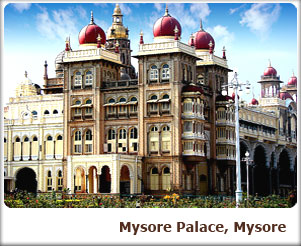 Day 20
Day 20 Mysore:
Breakfast will be at the hotel.
Proceed for the sightseeing.
The Chamundeshwari Temple, atop the hill of Chamundi, is of great religious significance. It is dedicated to the Goddess Chamundi or Durga, who killed the demon king. This temple earlier was a small one, but later was expanded under the Wodeyar rule. It displays Dravidian influence in some of its architecture. It is quadrangular in shape, and there is a statue of the Lord Ganesha on the doorway.
Another temple to see is the Mahabaleshwara Temple, which is said to be older than the Chamundeshwari Temple, which somehow lost its importance with the latter gaining significance. Inside this temple you can see images and statues which have been built in the styles of Hoysala, Ganga and Chola art.
The Mysore Palace is said to be the most magnificent and looks even more captivating on festive nights when it is lit up with as many as 97,000 light bulbs. Located in the city's centre, this is said to be the fourth one that stands there on the very same site.
This Palace is also called the Main Palace or the Amba Vilasa Palace, and it has drawn influences from Dravidian, Oriental, Roman and Indo-Saracenic architectural styles and is a three storeyed structure made of grey granite. You enter this palace through a Doll's Pavilion called Gombe Thotti, which is home to dolls from the 19th and 20th centuries.
Another interesting feature is the seven cannons in front of this pavilion which are still used at the beginning and end of the Dusshera festival. The Palace houses 12 temples.
The museums talk about the rich cultural past of the city. A museum to visit is the Jayachamarajendra Art Gallery inside the Jaganmohan Palace, which is a reservoir of rare art, artifacts, and paintings. A three-storeyed structure, the ground floor comprises paintings depicting the lineage of the Mysore Kings; the first floor with paintings from artist’s world over and in India; the second floor, home to many musical instruments; and the third floor once again with a gallery of paintings depicting the Dusshera processions.
Overnight will be at Mysore.
Day 21
Mysore – Srirangapatnam – Bangalore:
By Road 150Kms/04hrs
After breakfast proceed to Bangalore visiting Srirangapatnam enroute.
On the way visit Srirangapatnam - 16 km before Mysore, this fort was the stronghold of Tipu Sultan, son of Haider Ali. Tipu made a last minute ditch against the British in 1799 before surrendering his kingdom. Among the many fort buildings still intact, are Tipu's airy Summer Palace and his tomb at the Darya Daulat Bagh (garden). Here, is also the celebrated Sri Ranganatha Temple.
Reach Bangalore and check into the hotel.
Bangalore is a booming city and considered fifth largest and the fastest growing city in Asia. Bangalore combines a quaint old world charm with the hustle and bustle of a modern metropolitan city. It is a delightful place with an amalgamation of various rich cultures, crafts, and heritage centers. This city while enjoying the reputation of being a modern, high-tech city, still offers a lot of places of historical interest for the avid sightseer to explore. A trip around the city can be very interesting and provides a varied sightseeing experience with Palaces, museums, temples, churches and gardens. It has an enviable posterity and presents much to be discovered. Despite being one of Asia's fastest growing cities, Bangalore remains one of the most elegant metros in India. A well-planned city, with tree-lined avenues, a large number of parks, gardens and lakes, Bangalore is aptly called India's garden city. Bangalore is even gaining the status of the "Floriculture Capital of India" due to the present blossoming of flower exports from the city. The beautiful parks like the Lalbagh and Cubbon Park are indeed a treat to the eyes.
Enjoy shopping or just sit in one of the numerous modern pubs in downtown area just enjoying the latest music and crowd. It will be a nice experience as the weather in this city is pleasant all through the year.
Overnight will be at Bangalore.
Day 22
Bangalore - Departure:
After breakfast proceed for the sightseeing.
Cubbon Park: Lord Cubbon laid down the 300-acre park in 1864. A perfect place for joggers and nature walkers, it also has red Gothic structures to see such as the State Central Library with its rare treasure of books, architectural style and fluted pillars, the High Court, the Cheshire Dyer Memorial Hall, Ottawa Chatter, Museum, Century Club and the Press Club.
Lalbagh Gardens: A small fruit orchard of Hyder Ali, this garden had the glory of Tipu Sultan introducing several exotic trees here such as Cypress, Thuja, Junipers, Grapes, Guavas, Raspberries and Strawberries while John Cameron's period was certainly its 'Golden Era'. The Lalbagh Glass House once displayed the flora imported from England.
Vidhana Soudha: An imposing 46m high Bangalore granite monument that resembles the Temple architectural style houses the Legislative Chambers of the state government. The building has 22 departments and 300 rooms, four domes on all its corners and the four-headed lion.
Tipu’s Palace: Similar in many ways to the Summer Palace of Tippu Sultan at Sriangapatna, this palace was begun by Haider Ali and completed by Tippu in 1791. Known as `Rashk-e-jannat' (Envy of Heaven), it has massive wooden work and is known for five exquisitely ornamented arches with beautiful minarets and paintings on walls and ceilings.
Gandhi Bhavan: The Gandhi Smarak Nidhi (memorial of Father of India, Gandhiji) in the Gandhi Bhavan exhibits pictures and photos depicting Gandhiji's life from early childhood till the day of his death. One can also read copies of Gandhiji's letters to famous personalities of his time to fully comprehend his philosophy and his views on various subjects
Today as per the flight timings you will be transferred to the airport to take flight back home with sweet memories of the SOUTH INDIA TOUR.
...........................................................................TOUR ENDS...........................................................................INCLUSIONS:
- ACCOMODATION AT SUGGESTED HOTELS,
- DAILY BUFFET BREAKFASTS,
- AIR CONDITIONED VEHICLE WITH DRIVER FOR THE TOUR,
- SIGHTSEEING TOURS AS MENTIONED IN THE ITINERARY,
- MEET AND ASSIST SERVICES ON ARRIVAL AND DEPARTURE,
- ENGLISH SPEAKING GUIDE AT APPLICABLE PLACES,
- BHARATNATYAM DANCE PRESENTATION IN CHENNAI,
- AUROBINDO ASHRAM VISIT AT PONDICHERRY,
- EVENING PRAYER CEREMONY AT MEENAKSHI TEMPLE – MADURAI,
- OVERNIGHT STAY IN HOUSEBOAT,
- ALL MEALS IN HOUSEBOAT,
- DAY PACKAGE WITH BAMBOO RAFTING IN PERIYAR,
- SPICE PLANTATION TOUR IN PERIYAR,
- ELEPHANT RIDE IN PERIYAR,
- HARBOUR CRUISE IN COCHIN,
- KATHAKALI DANCE PRESENTATION IN COCHIN,
- TOY TRAIN RIDE FROM OOTY - COONOOR,
- ALL APPLICABLE TAXES AND SERVICE CHARGES, AND
- ALL PARKING WITH DRIVER ALLWANCES AND ROAD TAXES.
- LUNCHES & DINNERS,
- MONUMENT ENTRANCES,
- CAMERA CHARGES AT THE MONUMENTS,
- PORTER CHARGES,
- TIPS &
- PERSONAL EXPENSES.

